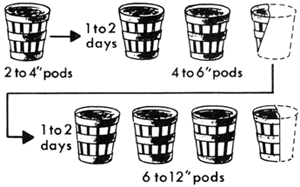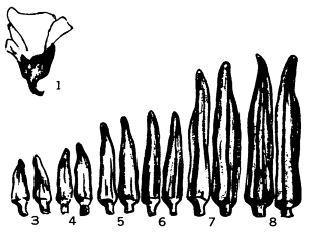
- Varieties
- Recommended Varieties
- Field Selection
- Land Preparation
- Fertilizer
- Planting
- Plant Pest Control
- Harvesting
Okra is grown in every county in Georgia. This popular vegetable can be found in both home and commercial gardens. A large acreage is planted under contract for the soup and frozen food industry.
Okra can be a profitable crop when recommended production practices are followed. It can return an income over a 10- to 12-week period after harvest starts.
Varieties
New okra varieties are not introduced as often as are those of some vegetables. However, plant breeders and commercial companies continue to improve existing varieties and some hybrids have been released. Varieties recommended for commercial production are listed in the table below.
Since some processors prefer a particular variety, you're urged to discuss this with the processor before buying seed. Some processors have a source of seed available for their growers.
Buyers for the fresh market generally prefer star shaped pods; soup manufacturers prefer a round pod of the Emerald type; the frozen food industry has accepted both types in the past.
Recommended Varieties
| Variety | Pod Shape | Days to Maturity |
Main Use | Other Comments |
| Emerald | Round | 57 | Canning | Semi-cut leaf |
| Louisiana Green Velvet | Round | 58 | Freezing | Retains seed when sliced |
| Clemson Spineless #80 | Star | 60 | Fresh Market | Heavy yields; also spineless |
| Dwarf Green Long Pod | Star | 52 | Fresh Market | Plant has several side branches |
| Hastings Improved Perkins | Star | 50 | Fresh Market | Deep cut leaf |
| Annie Oakley (Hybrid) | Star | 57 | Home-Local | Try on small scale to determine adaptability |
| UGA Red | Star | 58 | Home Garden | Red pod - ornamental and home use |
Field Selection
Soil
A well-drained, fertile soil is best for okra production. Select a soil with good water holding capacity. Do not plant on very light, sandy soils. Soils that are poorly drained or known to have hardpans should not be planted to okra.
Crop Rotation
Since okra is very susceptible to damage by nematodes, follow a crop rotation, using such crops as grasses and small grains, which prevent a buildup of nematode populations. Okra should not follow vine crops, such as squash and sweet potatoes. These crops tend to increase nematode population.
Land Preparation
Seedbed
Early land preparation is an important step in growing a good crop. Turning the soil in the fall or early spring will give crop residues time to decompose before okra is planted. Early land preparation also allows for many weed seed to germinate. These seedlings should be killed as you disk the soil before planting.
Fumigation
Since okra is very susceptible to nematodes, it is important to fumigate the soil if nematodes are present. You can determine if nematodes are present by sampling the soil. Your county Extension agent can advise you on how to take a nematode soil sample. He can also advise you on soil fumigation.
Fertilizer
Okra grows best on soils that have a pH of 5.8 to 6.5. A soil test will indicate if lime is required and will specify the amount of fertilizer to apply. If lime is recommended, use dolomitic lime. Apply it 3 or 4 months before the crop is seeded.
Research indicates that okra should respond to additional phosphate when the soil test indicates medium to low phosphate. If your soil test indicates low phosphate, broadcast 400 pounds per acre of 20 percent superphosphate and disk it in. If the soil test indicates medium phosphate, apply 200 pounds per acre of 20 percent superphosphate and disk it in.
If a soil test is not available, general recommendations are to apply 600 to 800 pounds per acre of a complete fertilizer such as 6-12-12 or 5-10-15. This can be mixed under the row or applied in a band to the side.
The okra plant has a sensitive balance between vegetative (foliage production) and reproduction (pod production). The use of additional nitrogen should be avoided on vigorous plantings until fruiting begins to check plant growth.
Two or more sidedressings with a high analysis nitrogen material may be needed, however, depending on rainfall. It is important to supply additional nitrogen late in the season at the time the "forms" or "blooms" are concentrated in the top of the plant. Put down 33 lb of additional nitrogen per acre at each application.
Planting
Seed the okra after the soil has warmed enough to allow good seed germination. Space rows 28 to 38 in. apart. These spacings will require 12 to 15 lb of seed per acre. Plant 1 1/2 to 2 in. deep, 4 to 6 seed per foot. Thin to 8 to 12 in. between plants.
Corn planters, such as the Cole planter, can be used for okra if the seed plate and cog are changed to plant this size seed. Planet Jr. type of seed planter is also suitable.
Plant Pest Control
Weeds
Weeds can be controlled by cultivation or by use of herbicides. Early weeds can be controlled by preplant herbicide applications. Later in the season, shallow cultivations can be used to control weeds. Refer to Extension Circular 695, "Weed Control in Vegetables."
Insects
At times it will be necessary to control insects that attack okra. Check your crop on a regular schedule, especially early in the season. This is the time that aphids usually appear. Later on, the plants and pods may be attacked by green stink bugs, cabbage loopers, corn earworms, European corn borers, and the leaf-footed plant bug. Consult with your county Extension agent and the Georgia Pest Control Handbook for control measures.
Diseases
Nematodes can cause serious losses in okra. Root-knot nematodes can be controlled by the use of approved nematicides. Nematicides are very essential if soil is infested with nematodes. Refer to the Georgia Pest Management Handbook and consult with your county Extension agent for approved control measures.
The incidence of Fusarium wilt is much greater when root-knot nematodes are present. Nematode control is a major practice in reducing Fusarium wilt presence.
Harvesting
The most important step in any okra operation is the pods correctly and at the proper time. Harvesting methods vary according to the market type.
Harvesting for Processing
Most varieties grown for processing produce pods on a brittle stem. These pods can be broken or snapped in a manner that leaves the stem on the plant and not on the pod. Okra grown for processing should be allowed to get as long as possible without becoming fibrous or hard. As long as the pod tip will snap off evenly the pod is usually still tender.

Processing
Pods 2 in. to 4 in. left to mature 1 to 2 days longer will yield about 2 1/3 times more weight. If left to mature 3 to 4 days longer, they will yield about 3 ½ times more weight.
Usually three harvests a week are required with process type of okra. Train your picking crews to grade okra as it is being harvested, discarding tough and damaged pods. Do not gather pods under 4 in. long. If left to reach maximum length, these pods will return a much greater weight per acre.
Harvesting for Fresh Market
Greater care is necessary in harvesting okra for the fresh market. Grading standards are more exact and the pods must usually be cut with a knife. Fresh market okra is usually graded into these sizes: Fancy—pods up to 3 1/2 in. long; Choice—pods 3 1/2 to 4 1/2 in. long; Jumbo—pods over 4 1/2 in. but still tender.
Be sure your picking crews are careful to neatly trim the stem end; this can be done as the pod is cut from the plant. To keeps pods small enough to grade as Fancy or Choice it will be necessary to harvest every day during periods of rapid growth.
Caution
Any mature pods left on the plant will reduce future yield. It is very important that all mature pods be removed from the plants as soon as possible. The practice of cuffing off (cropping) leaves during harvest does not influence future yields as long as leaves are not cut above where pods have not developed.
Fresh Market
Pods develop extremely fast. From bloom to Jumbo size takes only about 8 days. To get a maximum of Fancy and Choice pods (groups 3 & 4), you must harvest every day.

Trade and brand names are for information only. University of Georgia Cooperative Extension does not warrant the standard of any product mentioned; neither does it imply approval of any product to the exclusion of others which may also be suitable.
Status and Revision History
Published on Feb 24, 2009
Published with Full Review on Mar 31, 2014
Published with Full Review on Aug 01, 2017


























































